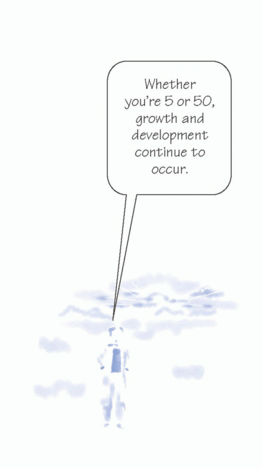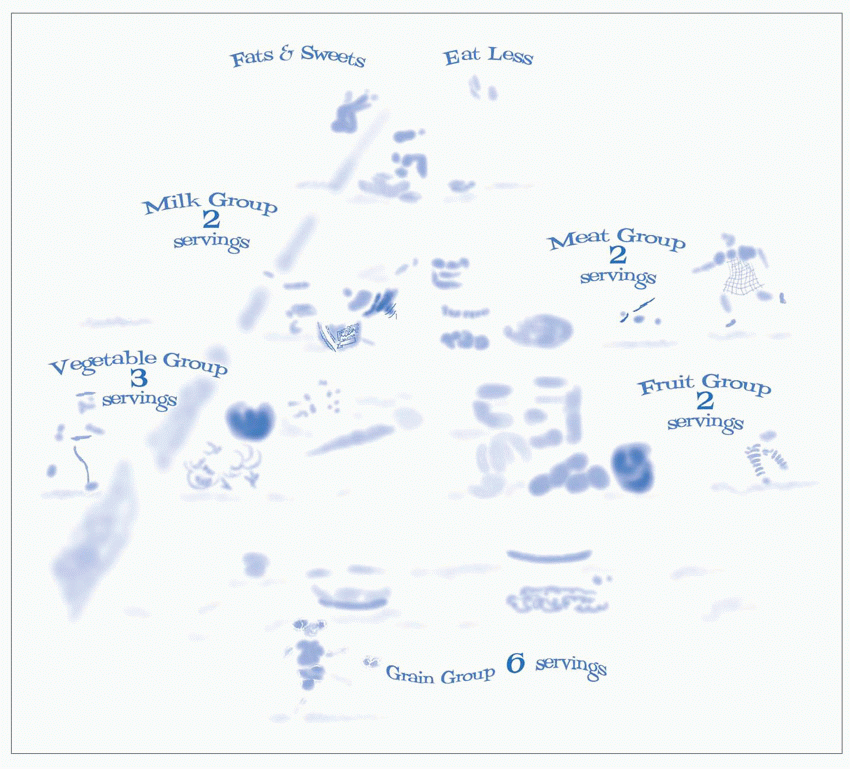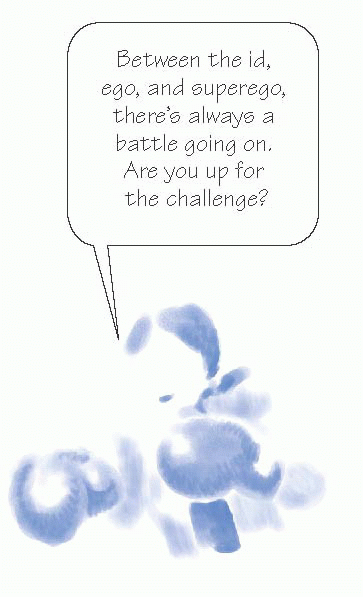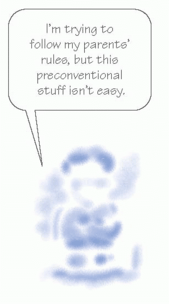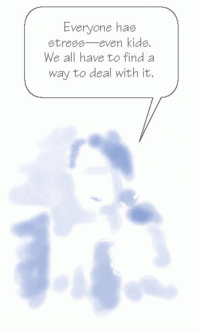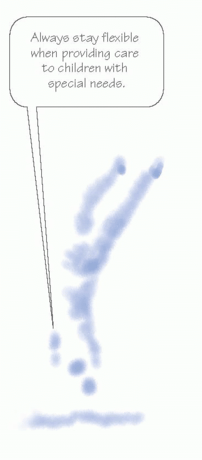Principles of growth and development
Growth and development occur throughout the life span.
Growth implies an increase in size, such as height and weight.
Development refers to the acquisition of skills and abilities that takes place throughout life. (See
Patterns of development,
page 14.)
Growth and development are essential parts of the pediatric nursing assessment. Problems that may initially seem insignificant might actually have severe consequences in later life if not dealt with early.
Stages of development
There are five stages of development during childhood:
 Infancy
Infancy is the period from birth until age 1.

The
toddler stage is the period from ages 1 to 3.

The
preschool stage lasts from ages 3 to 6.
 School-age
School-age refers to children ages 6 to 12.
 Adolescence
Adolescence is the period from ages 13 to 19. Some experts now consider the period of adolescence from ages 10 to 25 due to recent research on brain development.
Factors that influence growth and development
From birth on, children normally accomplish a series of developmental tasks during the stages of growth. As a child matures, he develops a readiness to master new, age-appropriate tasks.
Task master
A child’s ability to master these tasks is affected by environmental, social, cultural, and relational factors. Without the appropriate stimuli or environment, these tasks might not be accomplished, and development may be arrested or may occur in a maladaptive manner.
Family
The family in which a child is raised greatly influences his development. For example, a child who has been abused or neglected may experience delays in learning trust as well as disorders of attachment and problems with feeding and sleeping. Repeated episodes of maltreatment or emotional deprivation have been shown to also have a physical impact, decreasing a child’s rate of growth.
Health status
A child’s physiologic state can significantly affect his development. Children with chronic health conditions may experience developmental lags in acquiring skills relating to cognition, communication, adaptation, and social and motor functioning. The
extent to which a health condition affects a child’s development depends on the severity of the illness.
Socioeconomic status
A family’s socioeconomic status can have a significant impact on a child’s growth and development.
I could have been a contender
A lack of time and funds can also limit a child’s ability to pursue such special interests as art, music, and sports.
Cultural background
A family’s cultural beliefs and circumstances also affect a child’s growth and development. Culture influences the way children are socialized, learn values, and experience the world. The child’s developing beliefs, customs, mode of communication and dress, and actions are influenced by and vary according to culture.
Normal to me, taboo to you
Practices vary from culture to culture; what’s acceptable in one culture may be taboo in another. It’s extremely important for nurses to become knowledgeable about and respectful of cultural beliefs that differ from their own. This knowledge enables nurses to develop strategies for effective interventions. (See
Cultural influences on developmental assessment,
page 16.)
Basic necessities
A child must have such basic necessities as sleep, rest, and proper nutrition to reach his highest potential.
Children need more sleep than adults, and nurses should keep in mind that sleep deprivation can impact performance on growth and development assessments. Chronic sleep deprivation yields negative physiologic consequences.
Brain food
Nutritional deprivation can seriously interfere with brain development. Nutritional guidelines, such as the MyPlate guidelines from the U.S. Food and Drug Administration (FDA), should be taught to children and their parents to help them achieve optimum nutrition needed for normal growth and development. (See www.ChooseMyPlate.gov.)
Teach your children well
Beginning in infancy and continuing throughout the early years of childhood, the nurse, parents, and other significant people in the child’s life can teach habits of healthy eating and living. These healthy habits may prevent serious health problems as the child grows.
Other influences
Other influences on growth and development include genetics and heredity as well as the inborn personality or temperament of the child.
Theories of development
According to most theories of personality and cognitive development, certain tasks must be mastered before a child can advance to other, more advanced tasks. This process is similar to the patterns of biological development (cephalocaudal, proximodistal, general to specific). (See
Theories of development.)
Psychosocial development
A developmental framework for the entire life span was first proposed by Erik Erikson in 1959. Erikson’s psychosocial theory has been further refined but essentially remains the same today.
Erikson believed that the psychosocial development of an individual is a function of
ego (the conscious part of the personality—and the part that most immediately controls thought
and behavior) as well as social and biologic processes. At given times in the life cycle, the interaction between these processes cause psychosocial crises by placing a demand on the individual. In order for the person to grow, he must resolve these crises and master the task at hand.
He trusts me, he trusts me not
These tasks occur in eight different stages, five of which pertain to childhood. Each stage is characterized by a specific positive identity issue, such as trust in the infancy stage, and a contrasting negative attribute that may emerge from that issue, such as mistrust in the infancy stage. The prominence of either positive or negative attributes determines mastery of the crisis.
Weighing the pros …
If the positive attribute emerges, the individual has a better chance of experiencing unimpaired development.
… and the cons
If the negative attribute predominates, the individual may have problems with later attitudes and personal strength. Some negative attributes are, however, necessary to completely master the task at hand. As the person deals with each task, he assumes both increased vulnerability and increased potential, which garners new strength and pushes him on to the next level.
Hopeful today, caring tomorrow
Optimal development depends on the proper resolution of each task in the appropriate sequence. For example, the trust developed in infancy leads to a sense of hope, which forms a foundation for the emerging trait of fidelity in adolescence, and an ability to care in adulthood.
Stages of psychosocial theory
The five childhood stages of psychosocial theory are:
 trust versus mistrust (birth to age 1).
trust versus mistrust (birth to age 1). The child develops trust as the primary caregiver meets his needs.
 autonomy versus shame and doubt (ages 1 to 3).
autonomy versus shame and doubt (ages 1 to 3). The child learns to control his body functions and becomes increasingly independent, preferring to do things himself.
 initiative versus guilt (ages 3 to 6).
initiative versus guilt (ages 3 to 6). The child learns about the world through play and develops a conscience.
 industry versus inferiority (ages 6 to 12).
industry versus inferiority (ages 6 to 12). The child enjoys working on projects and with others and tends to follow rules;
competition with others is keen, and forming social relationships takes on greater importance.
 identity versus role confusion (ages 12 to 19).
identity versus role confusion (ages 12 to 19). Changes in the child’s body are taking place rapidly, and the child is preoccupied with how he looks and how others view him; while trying to meet the expectations of his peers, he’s also trying to establish his own identity.
Cognitive development
According to Jean Piaget, cognitive or intellectual acts occur when an individual is adapting to and organizing the perceived environment around him. Piaget thought a child moves through four stages of cognitive development. As he moves through each stage, he builds on structures gained from the previous stages, moving from relatively simple to very complex operations.
Some people never grow up!
Piaget noted that all individuals have the capability to achieve the most advanced levels of functioning, although not all will reach the final stages of development.
No problem too big
It’s through experience with the environment that development is pushed ahead. The child incorporates new ideas, skills, and knowledge into familiar patterns of thought and action.
When faced with a problem that’s new or too complex to fit into his existing pattern of thought, the child accommodates (draws on past experiences that are closest to his current problem to solve it).
Sensorimotor stage
The sensorimotor stage spans birth to age 2. During this stage, the child progresses from reflex activity, through simple repetitive behaviors, to imitative behaviors. Concepts to be mastered include:
object permanence—the understanding that objects and events continue to exist, even when they can’t be seen, heard, or touched directly
causality—the relationship between cause and effect
spatial relationships—the recognition of different shapes and the relationships between them (for example, placing a round object in a round hole).
Preoperational stage
The preoperational stage starts at age 2 and ends around age 7. This stage is marked by egocentricity (the child can’t comprehend a point of view different from his own). It’s a time of magical thinking and increased ability to use symbols and language. Concepts to be mastered include:
representational language and symbols—re-presenting a reality into internal knowledge through language acquisition, using symbolic play such as riding a broom like horse
transductive reasoning—generalization to the extent that items that share characteristics are labeled the same.
Concrete operational stage
During the concrete operational stage (ages 7 to 11), the child’s thought processes become more logical and coherent. He can use inductive reasoning (using facts gathered from one or more specific experiences to draw a general conclusion about a situation) to solve problems but still can’t think abstractly. The child is less self-centered during this stage. Concepts to be mastered include sorting, ordering, and classifying facts to use in problemsolving.
Formal operational thought stage
The formal operational thought stage, which runs from ages 11 to 20, is characterized by adaptability and flexibility. The adolescent can think abstractly, form logical conclusions from his observations, and establish and test hypotheses. Concepts to be mastered include abstract ideas and concepts, possibilities, inductive reasoning, and complex deductive reasoning.
Psychosexual development
Development of human sexuality is influenced by physical, emotional, and cultural aspects in the society in which we live. This sexuality is part of the total person, which develops over time. It’s expressed through many avenues, including a person’s attitudes, feelings, beliefs, and self-image.
Sexual feelings
Sigmund Freud theorized that sexual feelings are present in some form from the newborn period through adulthood. He felt human nature has two sides: rational intellect and irrational desires. Freud’s theory of psychosexual development is fairly controversial, yet it is still used. He focused more on the abnormal mind and function rather than on the normal functioning of children and tied the development of personality to sexual development.
Id, ego, and superego
According to the psychosexual theory, personality is composed of three entities:

The
id, the largest portion of the mind, is the center of our primitive instincts and requires immediate gratification. (The neonate is the epitome of the id.)

The
ego develops in infancy and is the conscious, rational part of the personality; it’s less inward seeking than the id, and recognizes the larger picture. (The ego acts as a censor to the id; if there’s conflict between the id and the ego, neuroses may develop.)

The
superego represents the person’s conscience and ideals; therefore, it’s in continuous battle with the id.
Five stages of development
Freud proposed five stages of development; these stages center around the early years of the person’s life and the parent-child relationship. At each stage, sexual energy, what Freud called instinctual libido, is focused on a different area of the body.
Each stage also centers on a conflict that must be resolved before the child can progress to the next stage. If the conflict isn’t resolved, the child becomes fixated in that stage and development is arrested.
I can’t get no … satisfaction
Satisfaction must be achieved before a person can move on to the next stage. If he isn’t fully satisfied, it’s possible he may never fully complete the stage.
How the individual responds to others depends on which stage he’s in. This was a hallmark theory in the field of psychology, although it’s relatively limited in its scope.
Oral stage
In the oral stage (birth to age 1), the child seeks pleasure through sucking, biting, and other oral activities. Oral stimulation reduces tension and provides sensual satisfaction.
Anal stage
The anal and urethral areas are of great interest in the anal stage (ages 1 to 3). The child goes through toilet training and learns to control his excreta.
Phallic stage
During the phallic stage (ages 3 to 6), the child is interested in his genitalia and various sensations and discovers the difference
between boys and girls. The child may love the opposite-sex parent and consider the parent of the same sex a rival. This is known as the
Oedipal (boys) or
Electra (girls)
complex.
Latency period
In the latency period (ages 6 to 12), the child expands on traits developed in earlier stages and concentrates on playing and learning. The child doesn’t focus on a particular area of the body during this stage.
The Oedipal or Electra complex resolves, and the child forms close relationships with other children of the same age and gender. Energy is directed toward physical and intellectual quests.
Genitalia stage
The production of sex hormones becomes intense during the genitalia stage (ages 12 and older), and the reproductive system reaches maturation. During this stage, the adolescent develops the capacity for object love and maturity.
Moral development
Lawrence Kohlberg’s ideas of moral reasoning (the basis for ethical behavior) are based on the work of Piaget and the American philosopher John Dewey.
Born free … of morals, that is!
Kohlberg’s theory is based on the premise that, at birth, all beings are devoid of morals, ethics, and honesty. Then, through different stages, the family, and then the larger society, instills values, morality, and a sense of right and wrong. As the child’s intelligence and ability to interact with others mature, his patterns of moral behavior mature as well.
Kohlberg, along with Piaget, believed that most moral development occurs through social interaction; he felt that development could be promoted through formal education.
Can we talk?
According to Kohlberg, it’s important to present a person with moral dilemmas for discussion, which helps him see the reasonableness of the next higher stage and progress toward it. Kohlberg based this discussion approach on the insight that a person develops as a result of cognitive conflicts in his current stage.
Three levels of moral development
Kohlberg proposed three levels of moral development through which the person must pass. As the child comprehends and understands a stage, he can then progress to the next stage.
Preconventional level of morality
At the preconventional level (ages 2 to 7), the child attempts to follow rules set by those in authority. He tries to adjust his behavior according to good and bad and to right and wrong.
Conventional level of morality
At the conventional level (ages 7 to 12), the child seeks conformity and loyalty. He attempts to justify, support, and maintain the social order, and he follows fixed rules.
Postconventional autonomous level of morality
At the postconventional level (ages 12 and older), the adolescent strives to construct a personal and functional value system independent of authority figures and his peers.
Caring for the hospitalized child
Hospitalization is a major stressor for any individual, but especially for a child. The child is in an unfamiliar surrounding, with unfamiliar people. His routine is disrupted, and he isn’t able to do things he normally does.
Added to these stressors are the fear, pain, and discomfort associated with the child’s illness or injury and, in many cases, the diagnostic and therapeutic interventions used to treat the child. What’s more, even a minor illness may be perceived by the family as life-threatening. This perception can trigger fears that may overwhelm the family’s coping skills and lead to crisis.
Developmentally appropriate interventions should be geared toward helping the child and his family cope with this very stressful time.
No place like home
Separation of the child from his parents, siblings, and usual support systems further adds to the emotional stress and discomfort a child feels when hospitalized. Parents (and siblings) should be encouraged and allowed to spend as much time as possible with the hospitalized child. When policy permits, arrangements should be made for a parent to spend the night in the child’s room or close by.
Minimizing the trauma of hospitalization
Preparing a child for hospitalization and any interventions will help the child cope more effectively and make it easier for him to trust the health care professionals responsible for his care.
Always be prepared
When possible, it’s ideal to prepare the child for admission to the hospital. The timing of the preparation and the amount of teaching given depend on the child’s age, developmental stage, personality, and the length of the procedure or treatment.
Young children may need only a few hours of preparation, whereas the older child may benefit from several days of preparation. The use of developmentally appropriate activities will also help the child cope with the stress of hospitalization. (See
The importance of play.)
Specialist on the job
Many hospitals have a child life specialist on staff, who can arrange a preadmission visit for the child and his parents. During these visits, the child and his parents tour the pediatric unit, helping to familiarize the child with the sights, sounds, and smells of the hospital. The child life specialist, an expert in child development, then explains, step-by-step, what the child can expect— especially relating to any planned procedures—and can also stay with the child during those procedures.
Keep it in the family
To reduce the fear that accompanies hospitalization, the nurse can help the child and family cope by:
explaining procedures
answering questions openly and honestly
minimizing separation from the parents
structuring the environment to allow the child to retain as much control as possible.
Patient- and family-centered care is an approach to health care that recognizes that the child patient and the family are integral members of the health care team. It allows the family to remain as involved as possible and helps give the child and his family a sense of control in a difficult and unfamiliar situation. It may also help
alleviate separation anxiety and reassure the child that all care is intended to help him get better. The child needs reassurance that the illness isn’t his fault and that fear is a normal response. All children should be encouraged to express their feelings.
Caring for the special needs child
All children go through times in their lives when parents, family, and others need to adapt to certain outside influences. How the child copes with these influences, either positive or negative, is determined by his strengths, personality, developmental stage, and support systems.
Chronic illness and disability
When a child has a chronic illness or is disabled, family members experience additional stress that has lasting implications for the child, his parents, and his siblings.
Flexibility required
Chronic or terminal illnesses, disabilities, or acute conditions that impact daily living require the family and the child to adapt their normal process of living and being; they also require health care professionals to adapt their usual way of providing care.
On the rise
Almost 20% of the pediatric population has a condition that would qualify them as having a special health care need. This percentage is increasing because of improved technology, health care, and treatments that increase survival rates.
Barriers to optimal care level
Children with special needs commonly require continuous and complex care. Oversight of care is usually provided by specialists who may or may not take into account alterations in development or the child’s response to the illness. Occasionally, this may mean that the child doesn’t receive preventive health services. Other barriers to optimal health care in the special needs child include financial, health care system, and knowledge barriers. For these reasons, it’s especially important for the nurse to help ensure that the child is up-to-date on immunizations, wellchild checkups, and routine health care.
Impact on the family
The diagnosis of a chronic condition may cause extreme distress in the family. Parents grieve over the loss of their “healthy” child
and may perceive him as vulnerable. This view may hinder the child in meeting the tasks required for him to grow and develop as normally as possible. Helping the family understand the condition and its impact on normal growth and development will help the child achieve his highest level of functioning. The complexity of care that a special needs child may have also increases the burden of care on the family or may further isolate a family from outside support systems. This added stress may increase the risk for child abuse and other forms of victimization to the child.
Hey, what about me?
Having a sibling with a chronic condition may elicit feelings of stress, helplessness, guilt, or depression. Siblings should be included in the family assessment of coping and should be provided with appropriate support. Older siblings commonly participate in providing care to a special needs child at home as much as the parents do. They must be included when providing care and teaching to the child.
Nursing strategies
Care and nursing interventions should be adapted to the child’s level of development.
 Just the facts
Just the facts Cultured pearls
Cultured pearls Growing pains
Growing pains trust versus mistrust (birth to age 1). The child develops trust as the primary caregiver meets his needs.
trust versus mistrust (birth to age 1). The child develops trust as the primary caregiver meets his needs. autonomy versus shame and doubt (ages 1 to 3). The child learns to control his body functions and becomes increasingly independent, preferring to do things himself.
autonomy versus shame and doubt (ages 1 to 3). The child learns to control his body functions and becomes increasingly independent, preferring to do things himself. initiative versus guilt (ages 3 to 6). The child learns about the world through play and develops a conscience.
initiative versus guilt (ages 3 to 6). The child learns about the world through play and develops a conscience. industry versus inferiority (ages 6 to 12). The child enjoys working on projects and with others and tends to follow rules;
industry versus inferiority (ages 6 to 12). The child enjoys working on projects and with others and tends to follow rules;  The id, the largest portion of the mind, is the center of our primitive instincts and requires immediate gratification. (The neonate is the epitome of the id.)
The id, the largest portion of the mind, is the center of our primitive instincts and requires immediate gratification. (The neonate is the epitome of the id.) The ego develops in infancy and is the conscious, rational part of the personality; it’s less inward seeking than the id, and recognizes the larger picture. (The ego acts as a censor to the id; if there’s conflict between the id and the ego, neuroses may develop.)
The ego develops in infancy and is the conscious, rational part of the personality; it’s less inward seeking than the id, and recognizes the larger picture. (The ego acts as a censor to the id; if there’s conflict between the id and the ego, neuroses may develop.)



